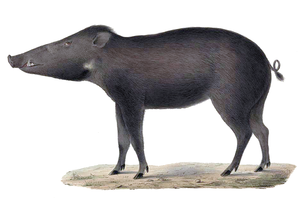Sulawesi pustular pig
| Sulawesi pustular pig | ||||||||||||
|---|---|---|---|---|---|---|---|---|---|---|---|---|

Sulawesi pustular pig ( Sus celebensis ) |
||||||||||||
| Systematics | ||||||||||||
|
||||||||||||
| Scientific name | ||||||||||||
| Sus celebensis | ||||||||||||
| Müller & Schlegel , 1843 |
The Sulawesi pustular pig ( Sus celebensis ), sometimes also called Celebes pig , is a species of mammal from the family of real pigs (Suidae) that lives in the Malay Archipelago . Sometimes it is kept semi-wild as a pet.
features
The fur of the Sulawesi pustular pigs is black and speckled with isolated yellow and white hair, but there are also reddish-brown specimens. The typical pig snout is surrounded by a light ring, on the forehead they have a mop of white hair. Like all pustular pigs , they have three pairs of pustular swellings on their faces , which increase with age. The legs are relatively short, the tail rather long and tasseled. These animals reach a head trunk length of 80 to 130 centimeters, the shoulder height is around 70 centimeters and the weight is between 40 and 70 kilograms.
distribution and habitat
Originally, Sulawesi pustular pigs were native to the island of Sulawesi (Celebes) and smaller offshore islands. They were introduced by humans to other islands in the Malay Arichipelago, such as Halmahera , Flores , Timor, and other islands in the Moluccas and Lesser Sunda Islands . The pigs are not picky about their habitat and inhabit rainforests as well as swamps and grasslands and occur in the mountains up to 2300 m above sea level.
Way of life
These pigs live in family groups, two or three families sometimes form associations. They tend to be active during the day, foraging mostly in the early morning and late afternoon. They are omnivores that eat roots, fruits, leaves, carrion, insects and other invertebrates.
Mating can occur year round, but most births occur in April or May. The gestation period is around four to five months, after which two to three (in exceptional cases up to ten) young animals are born. At birth, the female builds a nest in which the newborns spend their first days of life.
Sulawesi pustules and people
The Sulawesi pustular pig was introduced by humans to some Southeast Asian islands. The domestic pig populations on some islands in the Moluccas and New Guinea could also be traced back to this species or to hybrids with the wild boar . On some islands, Sulawesi pustelers are kept semi-wild as pets, which means they spend the day in the woods and return to the stables at night.
The species is still relatively common on Sulawesi itself, it has only become rare in the southern regions and on some offshore islands. The IUCN does not include them as an endangered species.
In addition to deer boars ( Babyrousa ), hand prints and anoas, visitors to the caves in the Maros-Pangkep region depicted the Sulawesi pustular pig in wall paintings as early as the Paleolithic around 40,000 years ago .
literature
- Ronald M. Nowak: Walker's Mammals of the World. Johns Hopkins University Press, Baltimore 1999, ISBN 0-8018-5789-9 .
- DE Wilson, DM Reeder: Mammal Species of the World. Johns Hopkins University Press, 2005, ISBN 0-8018-8221-4 .
Web links
- Sulawesi Warty Pig on Animal Diversity Web (English)
- Sulawesi Warty Pig on Ultimate ungulate (English)
- Sus celebensis in the endangered Red List species the IUCN 2006. Posted by: Pigs & peccaries Specialist Group, 1996. Accessed November 12 of 2006.
Individual evidence
- ↑ Indonesian cave paintings 'revolutionized our idea of human art' (English), Deutsche Welle , October 9, 2014